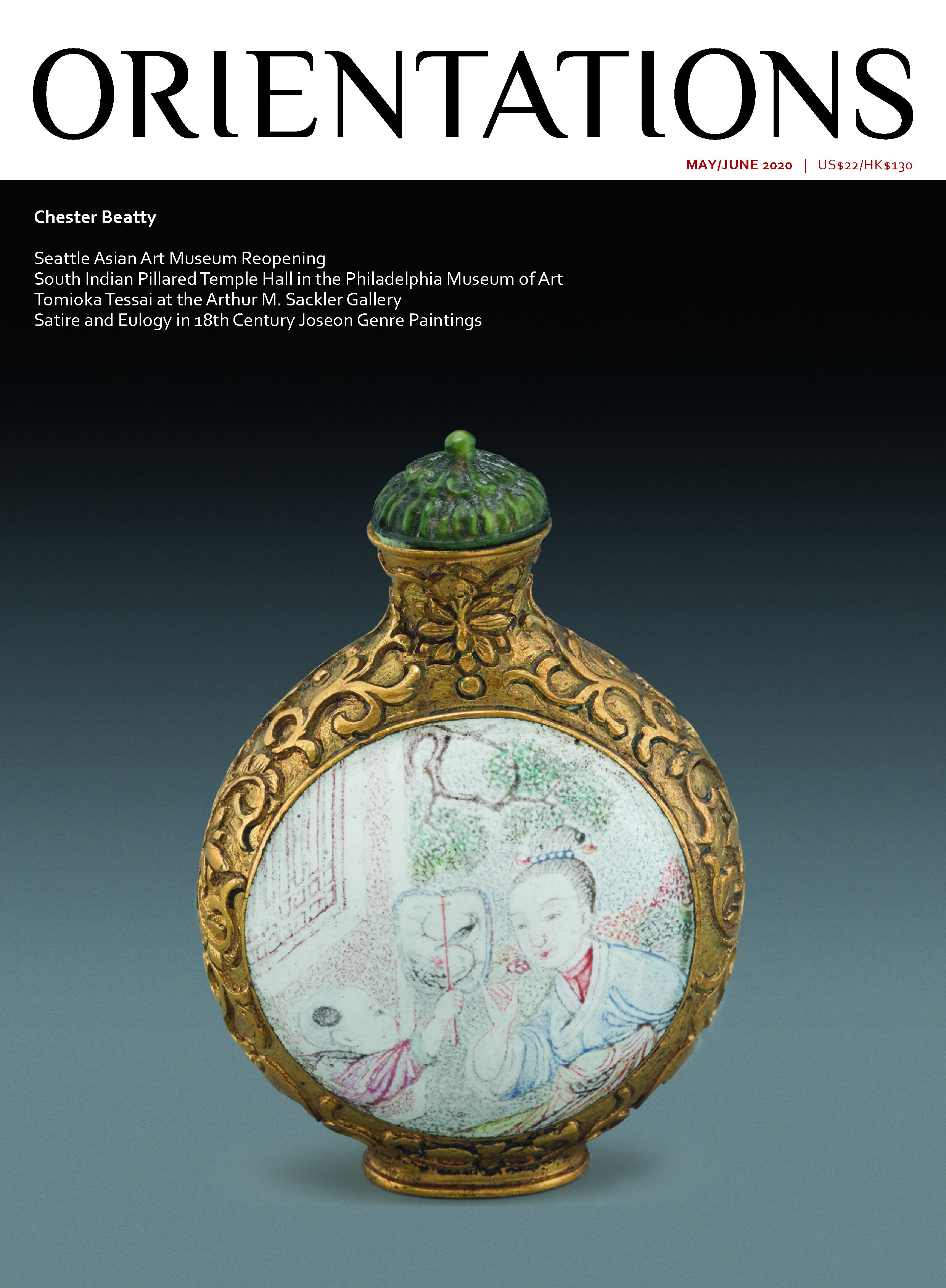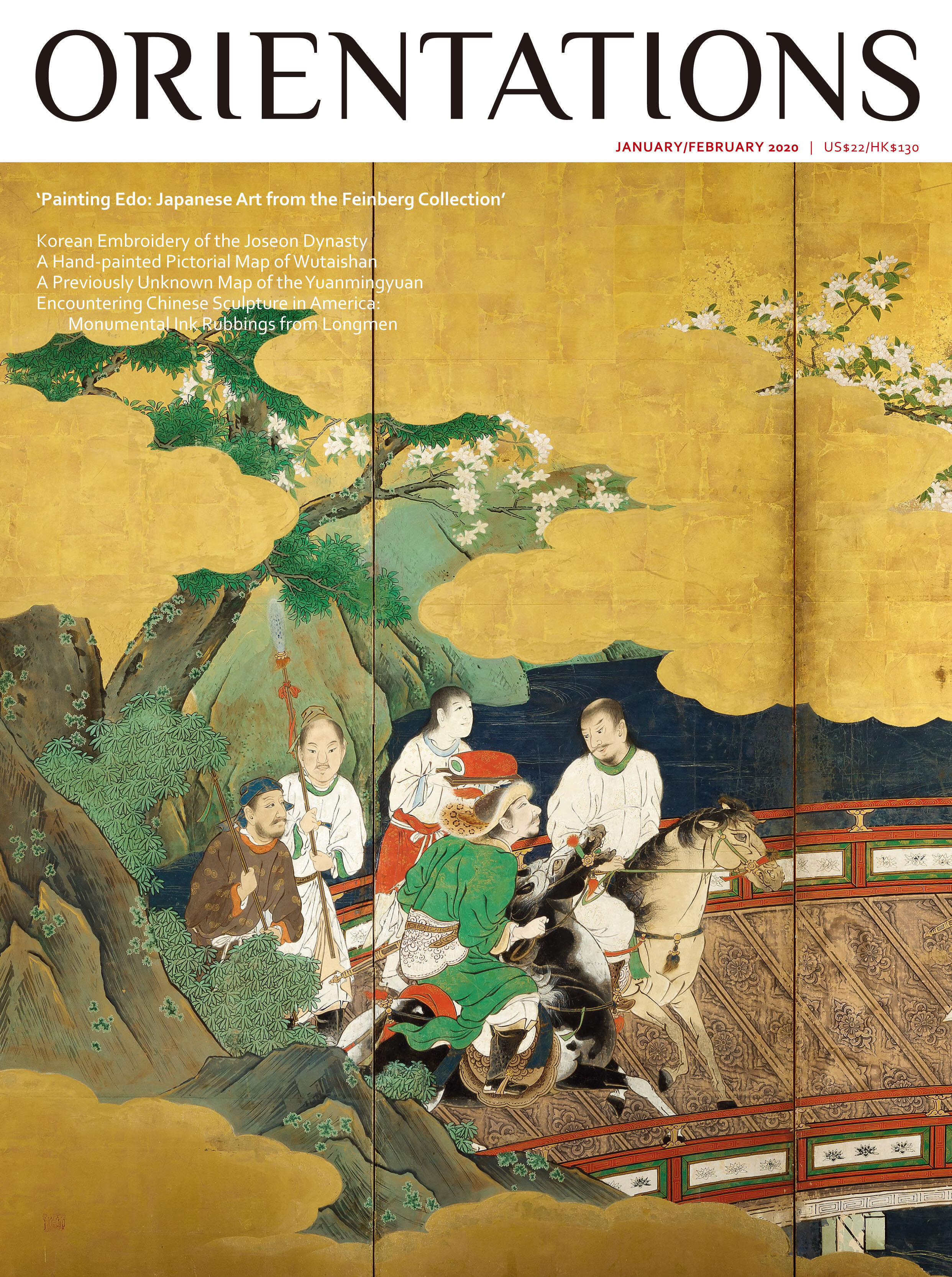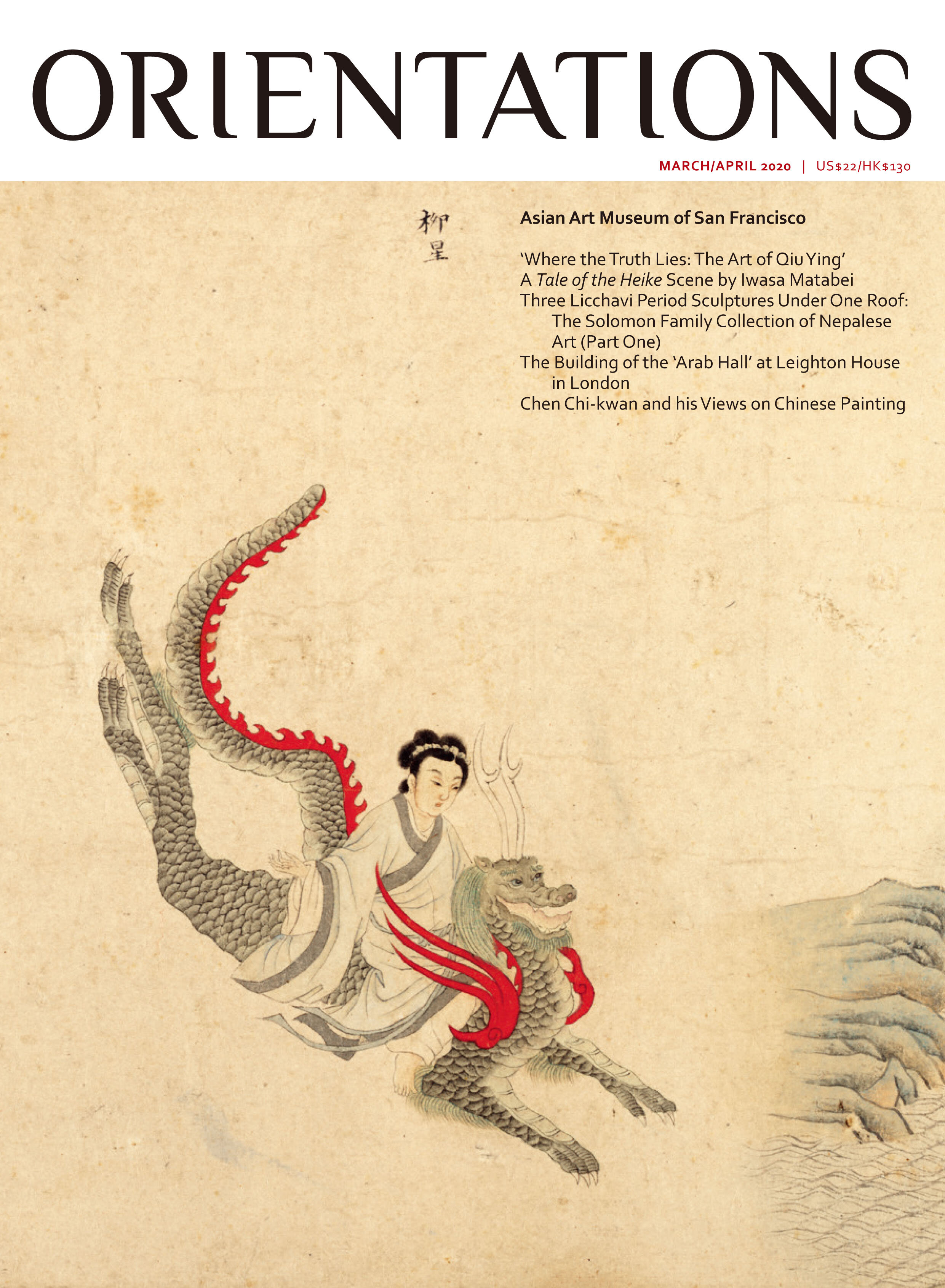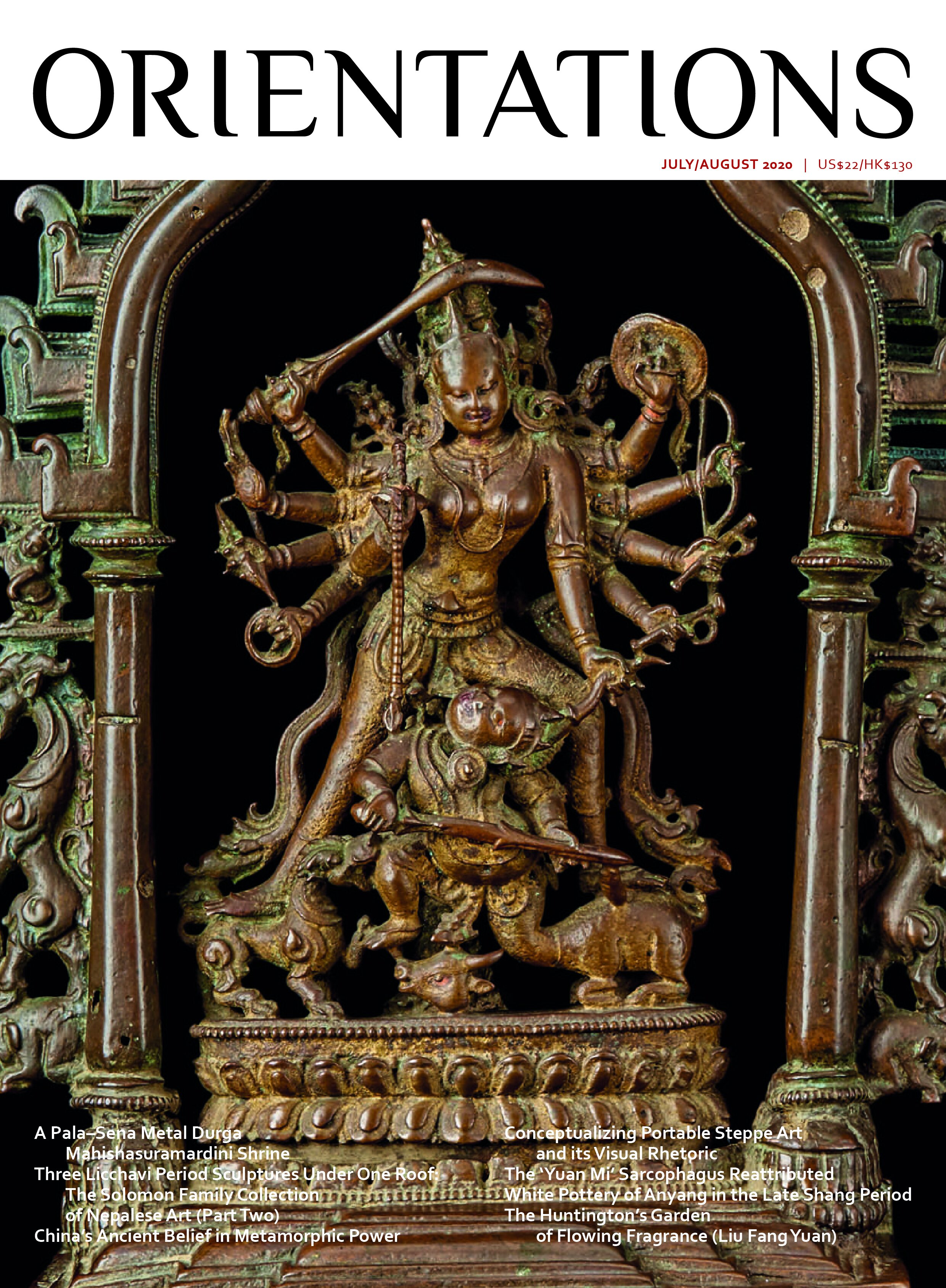NOV/DEC 2020
VOLUME 51 - NUMBER 6
The Jordan Schnitzer Museum of Art first opened in 1933, with over 3,700 Asian works of art. Donated by the museum’s founder Gertrude Bass Warner (1863– 1951), the Murray Warner Collection of Oriental Art includes an extensive selection of Chinese courttextiles. A centrepiece of the museum’s Betty and John Soreng Gallery of Chinese Art, which has recently undergone a long-awaited renovation, is an interpretation of a traditional Chinese treasure wall of decorative objects. We discuss the history of the collection and the refurbished gallery’s inaugural installation, ‘Myriad Treasures’.
The Palace Museum celebrates the 95th anniversary of its founding this October. From its opening to this day, the mystery and opulence of the Forbidden City have attracted and excited visitors. The Records of Decoration and Display (Chen she dang), a set of inventories documenting the furnishings of the Qing dynasty imperial palaces compiled by order of the Kangxi emperor in the 33rd year of his reign (1694), offers insights into life inside the palace. An examination of the Westernstyle scientific instruments listed in the record for the residence of Empress Dowager Xiaohuizhang (1641–1718), the official imperial consort of the Shunzhi emperor, contributes to the growing body of research on women in the Qing court.
In highly patriarchal societies where the majority of surviving texts are written by men, more often than not the roles played by women in social activities are omitted or downplayed. An early 15th century painting of the Buddhist goddess Ushnishavijaya, included in the exhibition ‘Dharma and Punya: Buddhist Ritual Art of Nepal’ at Cantor Art Gallery in autumn 2019, is one of the earliest paintings of the Laksha Chaitya Vrata ritual; the painting also incorporates a rare portrayal of a woman in a position of authority in a Buddhist setting.
We feature two European private collections of Asian art formed under very different circumstances. The first is that of Giovanni Battista Lucini Passalacqua (1845–89), a member of a prestigious 19th century Milanese family who from 1871 to 1872 journeyed to Japan and China, where he amassed a collection of over 5,000 works. While many great collections of Asian art were formed during this period, he was one of the few to actually visit Asia.
The second highlights the discovery of ‘an old Indian photograph album’ at Hunterston House in Scotland. In fact, the album comprises photographs of the Awadh court taken by the 1850s photographer Ahmad Ali Khan. The house also contains other items of ‘Lucknow loot’ secreted there by a previous owner, Lieutenant Colonel Gould Hunter-Weston, ironically one of the British officers tasked with preventing the looting of the city after the Indian Mutiny in 1857–58.
Chicago has always been a vibrant centre for the arts, including Asian art. A recent addition to the city is Wrightwood 659, a non-commercial art space that opened in 2018. The gallery is funded by Alphawood Foundation, a private foundation that makes grants in the areas of the arts, art education, architecture and historic preservation. We speak with the foundation’s executive director James D. McDonough on pressing social issues and how Wrightwood hopes to make an impact.
This is the last issue of this extraordinary year and we are grateful for the support of our readers and advertisers. We have been experimenting with digital versions of our issues this year and are pleased to announce that we will offer digital subscription plans starting in 2021. This is something that we have long intended, but circumstances have expedited the process. As they say: ‘Every cloud has a silver lining.’
FEATURES
Jinah Kim. Women in Action: Images of Women in the Buddhist Art of Medieval Eastern India and Nepal
Anne Rose Kitagawa. ‘Myriad Treasures’: Celebrating the Renovation and Reinstallation of the Soreng Gallery of Chinese Art
Rob Linrothe. Thirty Years On: Revisiting the Chuchikzhal Complex in Karsha
Joyce Yusi Zhou. Art and Science in the Empress Dowager’s Palace: An Investigation of the Ningshou Gong Display Record from the Kangxi Reign
Hye-shim Yi. From Epigraphy to Inscribing Objects: Recarving Ancient Relics into Inkstones
Francesco Morena. The Count’s Dream: The Lucini Passalacqua Collection of Chinese and Japanese Art
Hou-mei Sung. The New Identity of Hoen Taira Yoshiteru
Rosie Llewellyn-Jones.Indian Treasures in a Scottish Country House
PREVIEWS & REVIEWS
Curator's Choice. The Inalienable Artwork by Yukio Lippit
INTERVIEWS
An Interview with James D. McDonough Executive Director of Alphawood Foundation Chicago
VOLUME 51 - NUMBER 6
The Jordan Schnitzer Museum of Art first opened in 1933, with over 3,700 Asian works of art. Donated by the museum’s founder Gertrude Bass Warner (1863– 1951), the Murray Warner Collection of Oriental Art includes an extensive selection of Chinese courttextiles. A centrepiece of the museum’s Betty and John Soreng Gallery of Chinese Art, which has recently undergone a long-awaited renovation, is an interpretation of a traditional Chinese treasure wall of decorative objects. We discuss the history of the collection and the refurbished gallery’s inaugural installation, ‘Myriad Treasures’.
The Palace Museum celebrates the 95th anniversary of its founding this October. From its opening to this day, the mystery and opulence of the Forbidden City have attracted and excited visitors. The Records of Decoration and Display (Chen she dang), a set of inventories documenting the furnishings of the Qing dynasty imperial palaces compiled by order of the Kangxi emperor in the 33rd year of his reign (1694), offers insights into life inside the palace. An examination of the Westernstyle scientific instruments listed in the record for the residence of Empress Dowager Xiaohuizhang (1641–1718), the official imperial consort of the Shunzhi emperor, contributes to the growing body of research on women in the Qing court.
In highly patriarchal societies where the majority of surviving texts are written by men, more often than not the roles played by women in social activities are omitted or downplayed. An early 15th century painting of the Buddhist goddess Ushnishavijaya, included in the exhibition ‘Dharma and Punya: Buddhist Ritual Art of Nepal’ at Cantor Art Gallery in autumn 2019, is one of the earliest paintings of the Laksha Chaitya Vrata ritual; the painting also incorporates a rare portrayal of a woman in a position of authority in a Buddhist setting.
We feature two European private collections of Asian art formed under very different circumstances. The first is that of Giovanni Battista Lucini Passalacqua (1845–89), a member of a prestigious 19th century Milanese family who from 1871 to 1872 journeyed to Japan and China, where he amassed a collection of over 5,000 works. While many great collections of Asian art were formed during this period, he was one of the few to actually visit Asia.
The second highlights the discovery of ‘an old Indian photograph album’ at Hunterston House in Scotland. In fact, the album comprises photographs of the Awadh court taken by the 1850s photographer Ahmad Ali Khan. The house also contains other items of ‘Lucknow loot’ secreted there by a previous owner, Lieutenant Colonel Gould Hunter-Weston, ironically one of the British officers tasked with preventing the looting of the city after the Indian Mutiny in 1857–58.
Chicago has always been a vibrant centre for the arts, including Asian art. A recent addition to the city is Wrightwood 659, a non-commercial art space that opened in 2018. The gallery is funded by Alphawood Foundation, a private foundation that makes grants in the areas of the arts, art education, architecture and historic preservation. We speak with the foundation’s executive director James D. McDonough on pressing social issues and how Wrightwood hopes to make an impact.
This is the last issue of this extraordinary year and we are grateful for the support of our readers and advertisers. We have been experimenting with digital versions of our issues this year and are pleased to announce that we will offer digital subscription plans starting in 2021. This is something that we have long intended, but circumstances have expedited the process. As they say: ‘Every cloud has a silver lining.’
FEATURES
Jinah Kim. Women in Action: Images of Women in the Buddhist Art of Medieval Eastern India and Nepal
Anne Rose Kitagawa. ‘Myriad Treasures’: Celebrating the Renovation and Reinstallation of the Soreng Gallery of Chinese Art
Rob Linrothe. Thirty Years On: Revisiting the Chuchikzhal Complex in Karsha
Joyce Yusi Zhou. Art and Science in the Empress Dowager’s Palace: An Investigation of the Ningshou Gong Display Record from the Kangxi Reign
Hye-shim Yi. From Epigraphy to Inscribing Objects: Recarving Ancient Relics into Inkstones
Francesco Morena. The Count’s Dream: The Lucini Passalacqua Collection of Chinese and Japanese Art
Hou-mei Sung. The New Identity of Hoen Taira Yoshiteru
Rosie Llewellyn-Jones.Indian Treasures in a Scottish Country House
PREVIEWS & REVIEWS
Curator's Choice. The Inalienable Artwork by Yukio Lippit
INTERVIEWS
An Interview with James D. McDonough Executive Director of Alphawood Foundation Chicago
VOLUME 51 - NUMBER 6
The Jordan Schnitzer Museum of Art first opened in 1933, with over 3,700 Asian works of art. Donated by the museum’s founder Gertrude Bass Warner (1863– 1951), the Murray Warner Collection of Oriental Art includes an extensive selection of Chinese courttextiles. A centrepiece of the museum’s Betty and John Soreng Gallery of Chinese Art, which has recently undergone a long-awaited renovation, is an interpretation of a traditional Chinese treasure wall of decorative objects. We discuss the history of the collection and the refurbished gallery’s inaugural installation, ‘Myriad Treasures’.
The Palace Museum celebrates the 95th anniversary of its founding this October. From its opening to this day, the mystery and opulence of the Forbidden City have attracted and excited visitors. The Records of Decoration and Display (Chen she dang), a set of inventories documenting the furnishings of the Qing dynasty imperial palaces compiled by order of the Kangxi emperor in the 33rd year of his reign (1694), offers insights into life inside the palace. An examination of the Westernstyle scientific instruments listed in the record for the residence of Empress Dowager Xiaohuizhang (1641–1718), the official imperial consort of the Shunzhi emperor, contributes to the growing body of research on women in the Qing court.
In highly patriarchal societies where the majority of surviving texts are written by men, more often than not the roles played by women in social activities are omitted or downplayed. An early 15th century painting of the Buddhist goddess Ushnishavijaya, included in the exhibition ‘Dharma and Punya: Buddhist Ritual Art of Nepal’ at Cantor Art Gallery in autumn 2019, is one of the earliest paintings of the Laksha Chaitya Vrata ritual; the painting also incorporates a rare portrayal of a woman in a position of authority in a Buddhist setting.
We feature two European private collections of Asian art formed under very different circumstances. The first is that of Giovanni Battista Lucini Passalacqua (1845–89), a member of a prestigious 19th century Milanese family who from 1871 to 1872 journeyed to Japan and China, where he amassed a collection of over 5,000 works. While many great collections of Asian art were formed during this period, he was one of the few to actually visit Asia.
The second highlights the discovery of ‘an old Indian photograph album’ at Hunterston House in Scotland. In fact, the album comprises photographs of the Awadh court taken by the 1850s photographer Ahmad Ali Khan. The house also contains other items of ‘Lucknow loot’ secreted there by a previous owner, Lieutenant Colonel Gould Hunter-Weston, ironically one of the British officers tasked with preventing the looting of the city after the Indian Mutiny in 1857–58.
Chicago has always been a vibrant centre for the arts, including Asian art. A recent addition to the city is Wrightwood 659, a non-commercial art space that opened in 2018. The gallery is funded by Alphawood Foundation, a private foundation that makes grants in the areas of the arts, art education, architecture and historic preservation. We speak with the foundation’s executive director James D. McDonough on pressing social issues and how Wrightwood hopes to make an impact.
This is the last issue of this extraordinary year and we are grateful for the support of our readers and advertisers. We have been experimenting with digital versions of our issues this year and are pleased to announce that we will offer digital subscription plans starting in 2021. This is something that we have long intended, but circumstances have expedited the process. As they say: ‘Every cloud has a silver lining.’
FEATURES
Jinah Kim. Women in Action: Images of Women in the Buddhist Art of Medieval Eastern India and Nepal
Anne Rose Kitagawa. ‘Myriad Treasures’: Celebrating the Renovation and Reinstallation of the Soreng Gallery of Chinese Art
Rob Linrothe. Thirty Years On: Revisiting the Chuchikzhal Complex in Karsha
Joyce Yusi Zhou. Art and Science in the Empress Dowager’s Palace: An Investigation of the Ningshou Gong Display Record from the Kangxi Reign
Hye-shim Yi. From Epigraphy to Inscribing Objects: Recarving Ancient Relics into Inkstones
Francesco Morena. The Count’s Dream: The Lucini Passalacqua Collection of Chinese and Japanese Art
Hou-mei Sung. The New Identity of Hoen Taira Yoshiteru
Rosie Llewellyn-Jones.Indian Treasures in a Scottish Country House
PREVIEWS & REVIEWS
Curator's Choice. The Inalienable Artwork by Yukio Lippit
INTERVIEWS
An Interview with James D. McDonough Executive Director of Alphawood Foundation Chicago






